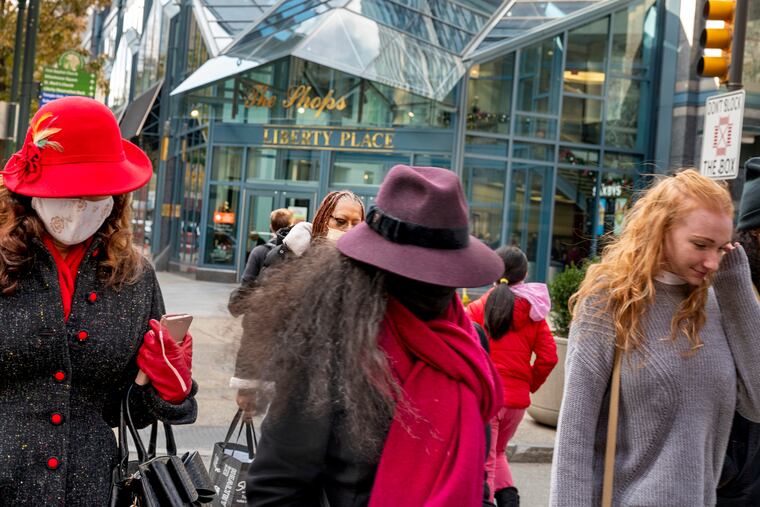Inflation will ease if the pandemic recedes, Moody’s Mark Zandi argues
For the typical American household, the acceleration in inflation is a big blow. But price hikes could taper off if the pandemic can be stopped.

Inflation is back. After being dormant for much of the last quarter-century, inflation has taken off in recent months. Prices are up a lot for most everything: a gallon of gas, vehicles, appliances, clothing, and even the cost of this Thanksgiving’s dinner.
For the typical American household, the acceleration in inflation is a big financial blow. It now costs $200 more a month to buy the same things as a year ago. And that $200 is roughly the monthly amount a household spent just on clothing or just on furniture and appliances before the pandemic.
» READ MORE: At the Manheim Auto Auction, used-car prices rise to record highs
The critical question is how long this uncomfortably high inflation will go on. The answer, perhaps not surprisingly, is that it depends on the pandemic. The pandemic, and more specifically the delta-variant wave of COVID-19 that peaked in mid-September, did a lot of economic damage, slowing growth and igniting the high inflation.
Delta was especially pernicious. While it hit us hard, it hit Asia even harder, and that’s where most global supply chains begin. China and many Southeast Asian economies have a no-COVID-19 policy — they shut things down if they spot even one case. Semiconductor plants in Malaysia that produce chips for cars and consumer electronics were shuttered, port terminals in China were closed, and clothing manufacturers in Vietnam stopped operations. This explains the shortages and spiking prices for lots of goods.
Labor shortages, which have been plaguing businesses since the vaccine rollout and the economy’s quick reopening last spring, were also exacerbated by the delta wave. Millions couldn’t work because they got sick with the virus, needed to care for sick family members, or were fearful of getting sick. Businesses have pushed up wages and given signing bonuses to help fill open positions and are passing along the higher costs to customers.
Many consumers, already on edge, were spooked by the rising infections and hospitalizations and pulled back on travel and eating out and used some of their freed-up cash to buy the very things that are now scarce because of the supply-chain disruptions and labor shortages. With store shelves and warehouses emptied out, prices have jumped even more.
» READ MORE: How Philly-area businesses adapted to supply chain bottlenecks, from stockpiling shingles to cutting chickens
The pandemic has also scrambled demand and supply in many markets, among the most vital being the global oil market. Global oil demand and supply were crushed early on in the pandemic. Demand has since recovered and is almost back to where it was pre-pandemic. However, while producers are pumping more oil, they have been slow to increase production consistent with the stronger demand. That’s why we are paying almost $3.50 for a gallon of regular, up from just over $2 a year ago.
Higher gas prices are especially hard on people’s pocketbooks and psyche. Since we all buy gas, and it is a price we will see at least a couple of times a day, nothing is more disturbing than watching it rocket higher. This has hammered consumer sentiment surveys and President Joe Biden’s approval rating. The higher gas prices also add to inflation more broadly, particularly for food, since a big part of the cost of getting food on store shelves is the cost of trucking it.
If you buy into my diagnosis for what’s behind the inflation surge, it should give you some comfort that inflation will moderate as the pandemic winds down. Of course, it would be Pollyannaish to think there won’t be future waves of infections. Indeed, one may already be underway.
But it is reasonable to think that each new wave will be less disruptive to the health-care system and economy than the previous one. If so, inflation will still sting for another several months, but it should be much less painful a year from now.
You will soon know if my inflation outlook is on the money. Oil and gasoline prices should be peaking now and will decline as OPEC and U.S. oil-frackers steadily increase output, enticed by the current high prices.
Food prices will then decline as it gets less costly for truckers to haul produce and meat to grocery stores. New and used vehicle prices will fall next as automakers get the semiconductors needed to build more cars and replenish depleted dealers’ lots. And while prices for apparel, appliances, and furniture won’t fall as much, good bargains will be around by next summer.
» READ MORE: Philly cheesesteaks, Wawa hoagies, and soft pretzels are getting more expensive. Blame inflation.
To be sure, inflation will remain a problem for some things even as the pandemic winds down. Rents come quickly to mind. They have been rising fast given the lack of affordable homes. There is a severe shortage of homes for rent and sale. Rent growth is especially juiced up now as twenty-something millennials who went back to live with their parents during the worst of the pandemic move back out. This movement will end soon, and rent growth will moderate, but the housing shortage will take time to resolve, and rents will continue to increase strongly.
It is wise to view any forecast with skepticism, but odds are good that the pandemic will continue to recede and inflation will soon move back into hibernation.
Mark Zandi is chief economist of Moody’s Analytics.